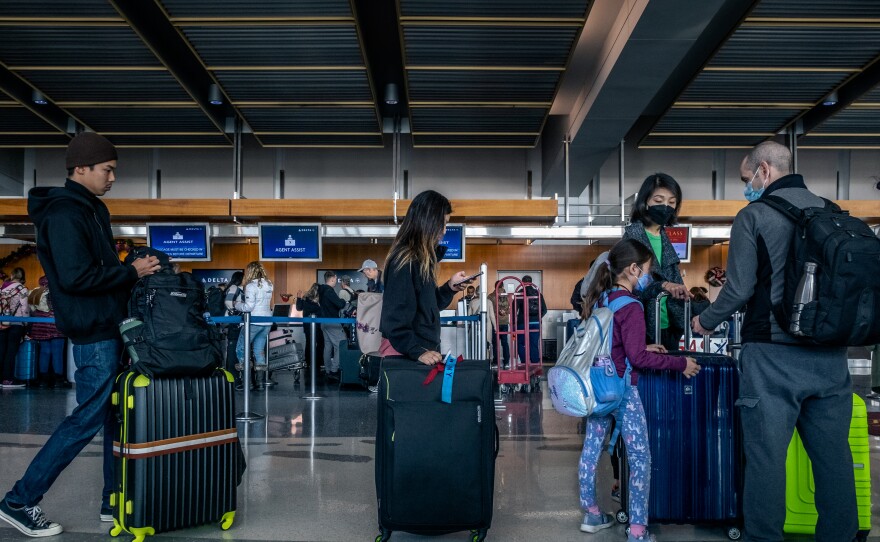The number of hospitalized COVID-19 patients has climbed throughout the holiday season, and with end-of-year travel and new omicron subvariants taking hold in San Diego County, experts worry the trend could continue.
As of Dec. 28, nearly 480 confirmed and suspected COVID-19 patients were hospitalized – more than double the count on Thanksgiving. Since October, the average daily rate of confirmed cases in San Diego County has nearly tripled, reaching 19.7 per 100,000 people as of Dec. 24, and the county reported 15 new deaths this week. Currently, the CDC places San Diego in the “medium” COVID-19 community level.
The flu has surged this fall, too – months earlier than in past years – leading to more than 19,000 infections and 29 deaths so far in San Diego County. In the previous five years, San Diego County averaged around 11,000 cases per year.
“Usually, our peak is late January … or later in February,” said Wilma Wooten, public health officer for San Diego County. “The only thing that's predictable about influenza is that it is unpredictable.”
Although the seven-day average number of newly reported COVID-19 cases dipped slightly in December, those numbers could rise again as post-holiday data comes in.
The coronavirus mutates as it spreads, leading to variants and subvariants that vary in their transmissibility, severity and immune evasion. The omicron variant that appeared last year led to a huge spike in cases last winter, and its subvariants still account for most infections.
In San Diego County, the omicron subvariant BQ.1.1 has become the predominant form of the virus since first appearing in wastewater sampling data in October. Another subvariant, XBB, has become the most common in the northeast United States. Wastewater sampling shows XBB appeared in San Diego County in late November.
“It seems to be more immune evasive and so we may also see more hospitalizations, more illness,” said Corinne McDaniels-Davidson, epidemiologist and the director of the San Diego State University Institute for Public Health.
“I think we have two weeks, maybe three weeks of pain still coming – COVID cases and flu cases,” said Dr. Davey Smith, head of infectious diseases at University of California San Diego. “We're only a few days past Christmas, so it's really hard to tell.”
Smith added that previously authorized monoclonal antibodies do not work against the most common subvariants now spreading in San Diego, limiting effective treatment options for people susceptible to severe disease, such as the elderly, immunocompromised or those with chronic health conditions.
Although the virus has changed, the methods for preventing COVID-19 remain the same: masking, distancing, hygiene, ventilation and vaccines.
While 81% of eligible people in San Diego County have been vaccinated, only 21% have received the newer bivalent booster meant to combat omicron. The newer subvariants may be more likely to cause breakthrough infection, although doctors still recommend the vaccines to prevent severe infection, hospitalization and death.
“A lot of people don't even know that there's a bivalent booster available that's any different from the previous booster,” said McDaniels-Davidson. “I think that there's been kind of a milquetoast push behind it.”
While community spread has increased in recent weeks, county officials aren’t weighing any new masking requirements at this time.
“We’re in a different phase of COVID-19,” Wooten said. “Our recommendations follow the science and we align with CDC, as well as [the California Department of Public Health] in those recommendations.”
Given the backlash against measures that were deemed too restrictive – or not restrictive enough, depending on your point of view — McDaniels-Davidson said it makes sense that local officials would follow the CDC’s lead.
“A lot of folks are very nervous to say, ‘You know what? We really should all be wearing masks,’ ” she said.
Therefore, she said, the federal government should issue stronger guidance on how local officials should act as cases and hospitalizations rise and new variants spread. With San Diego County currently placed in the “medium” community level, the CDC currently recommends masks for people at risk of severe infection or testing who have contact with high-risk individuals.
Holidays, when friends and family often travel to spend time together, could also serve to spread COVID-19, Smith said.
“A lot of young people will have this infection, asymptomatically, and then they'll bring it to these holiday parties and it's a disaster,” he said. “I just see too many families grieving over their relatives and realizing that they had a part to play in that travesty. And that's just heartbreaking.”







